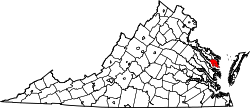Lancaster County | |
|---|---|
 Central Lancaster, the county seat, with the county courthouse visible | |
 Location within the U.S. state of Virginia | |
 Virginia's location within the U.S. | |
| Coordinates: 37°43′N76°25′W / 37.71°N 76.41°W | |
| Country | |
| State | |
| Founded | 1651 |
| Seat | Lancaster |
| Largest town | Kilmarnock |
| Area | |
• Total | 231 sq mi (600 km2) |
| • Land | 133 sq mi (340 km2) |
| • Water | 98 sq mi (250 km2) 42.4% |
| Population (2020) | |
• Total | 10,919 |
| • Density | 82.1/sq mi (31.7/km2) |
| Time zone | UTC−5 (Eastern) |
| • Summer (DST) | UTC−4 (EDT) |
| Congressional district | 1st |
| Website | www |
Lancaster County is a county located on the Northern Neck in the Commonwealth of Virginia. As of the 2020 census, the population sits at 10,919. [1] Its county seat is Lancaster. [2]
Contents
- History
- Geography
- Adjacent counties
- Major highways
- Demographics
- 2020 census
- 2000 Census
- Economy
- Government
- Board of Supervisors
- Constitutional officers
- Communities
- Towns
- Census-designated places
- Other unincorporated communities
- Points of interest
- See also
- References
Located on the Northern Neck near the mouth of the Rappahannock River, Lancaster County is part of the Northern Neck George Washington Birthplace wine-growing region recognized by the United States as an American Viticultural Area. [3] The largest town in Lancaster County is Kilmarnock, Virginia. The county's area code is 804.


